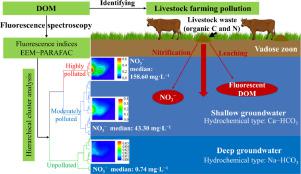Water Research ( IF 11.4 ) Pub Date : 2021-10-13 , DOI: 10.1016/j.watres.2021.117754 Yuanzheng Zhang 1 , Yunde Liu 2 , Aiguo Zhou 3 , Li Zhang 4

|
Extensive livestock farming has highly threatened groundwater quality, thereby necessitating a rapid and effective method to identify groundwater quality in such areas. Fluorescence spectroscopy has been recognized as an interpretable method for tracking anthropogenic influences on water quality, but its applicability in identifying the groundwater pollution from livestock farming remains unknown. In this study, the fluorescence characteristics of dissolved organic matter (DOM) in groundwater from a typical livestock farming area were investigated by using fluorescence excitation emission matrix (EEM)-parallel factor analysis (PARAFAC) coupled with multivariate statistical methods. The results showed that livestock farming significantly altered the content and composition of DOM in groundwater, and these effects were mainly observed in shallow groundwater in the study area. Hierarchical cluster analysis based on fluorescence parameters divided the groundwater samples into three clusters with significantly different pollution degrees: Cluster A, unpolluted; Cluster B, highly polluted; Cluster C, moderately polluted. In particular, the intensity of tryptophan-like fluorescence was high in the polluted groundwater but was almost undetectable in the unpolluted groundwater, suggesting that it is a potential indicator of groundwater quality. Principal component analysis based on the fluorescence parameters explained 91.5% of the variance with the first two principal components, and revealed that the degree of pollution dominated the fluorescence characteristics of groundwater in the study area. In addition, NO3– was abundant in Clusters B and C, while it was low in Cluster A, validating the analysis results of fluorescence spectroscopy. These findings indicated that DOM fluorescence was sensitive to livestock farming pollution and could be applied to identify, monitor, and assess groundwater pollution from livestock farming.
中文翻译:

使用荧光光谱结合多元统计方法识别畜牧业地下水污染
粗放式畜牧业严重威胁地下水质量,因此需要一种快速有效的方法来确定这些地区的地下水质量。荧光光谱已被公认为跟踪人为对水质影响的可解释方法,但其在识别畜牧业地下水污染方面的适用性仍然未知。本研究采用荧光激发发射矩阵(EEM)-平行因子分析(PARAFAC)结合多元统计方法研究了典型畜牧养殖区地下水中溶解有机物(DOM)的荧光特征。结果表明,畜牧业显着改变了地下水中 DOM 的含量和组成,这些影响主要在研究区的浅层地下水中观察到。基于荧光参数的分层聚类分析将地下水样品分为三个污染程度显着不同的聚类:聚类A,未污染;集群B,高度污染;集群 C,中度污染。特别是受污染的地下水中色氨酸类荧光强度较高,但在未受污染的地下水中几乎检测不到,表明它是地下水质量的潜在指标。基于荧光参数的主成分分析解释了与前两个主成分91.5%的方差,揭示了污染程度主导了研究区地下水的荧光特征。此外,NO 基于荧光参数的分层聚类分析将地下水样品分为三个污染程度显着不同的聚类:聚类A,未污染;集群B,高度污染;集群 C,中度污染。特别是受污染的地下水中色氨酸类荧光强度很高,而在未受污染的地下水中几乎检测不到,表明它是地下水质量的潜在指标。基于荧光参数的主成分分析解释了与前两个主成分91.5%的方差,揭示了污染程度主导了研究区地下水的荧光特征。此外,NO 基于荧光参数的分层聚类分析将地下水样品分为三个污染程度显着不同的聚类:聚类A,未污染;集群B,高度污染;集群 C,中度污染。特别是受污染的地下水中色氨酸类荧光强度很高,而在未受污染的地下水中几乎检测不到,表明它是地下水质量的潜在指标。基于荧光参数的主成分分析解释了与前两个主成分91.5%的方差,揭示了污染程度主导了研究区地下水的荧光特征。此外,NO 中度污染。特别是受污染的地下水中色氨酸类荧光强度很高,而在未受污染的地下水中几乎检测不到,表明它是地下水质量的潜在指标。基于荧光参数的主成分分析解释了与前两个主成分91.5%的方差,揭示了污染程度主导了研究区地下水的荧光特征。此外,NO 中度污染。特别是受污染的地下水中色氨酸类荧光强度很高,而在未受污染的地下水中几乎检测不到,表明它是地下水质量的潜在指标。基于荧光参数的主成分分析解释了与前两个主成分91.5%的方差,揭示了污染程度主导了研究区地下水的荧光特征。此外,NO 与前两个主成分的方差为 5%,表明污染程度主导了研究区地下水的荧光特征。此外,NO 与前两个主成分的方差为 5%,表明污染程度主导了研究区地下水的荧光特征。此外,NO3 -在簇 B 和 C 中含量丰富,而在簇 A 中含量较低,验证了荧光光谱的分析结果。这些发现表明DOM荧光对畜牧业污染敏感,可用于识别、监测和评估畜牧业地下水污染。










































 京公网安备 11010802027423号
京公网安备 11010802027423号